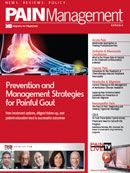Publication
Article
Pain Management
Some Thoughts Regarding the New Evidence-based Guidelines for Prevention of Episodic Migraine
Author(s):
A review of the guidelines published by the American Headache Society and the American Academy of Neurology (AAN) in the April 2012 issue of Neurology reveals some interesting surprises.
Gary W. Jay, MD, FAAPM
A review of the guidelines published by the American Headache Society and the American Academy of Neurology (AAN) in the April 2012 issue of Neurology (http://bit.ly/O5l83Q) reveals some interesting surprises.
One reason for this is that the AAN downgraded studies that had completion rates of less than 80%. This means that some of the drugs commonly used for prophylaxis are no longer labeled as Level A (recommendations based on data from at least two Class I studies). The guideline authors conducted a literature search for articles focused on migraine prevention, identifying 284 studies, of which only 29 qualified as Class 1 or Class II. They reviewed these studies and incorporated the data into their conclusions, rejecting studies with low completion rates; studies that did not assess the efficacy of treatment for episodic migraine in adults; studies that assessed acute migraine treatment, migraine aura treatment or prevention, or behavioral approaches; and studies that looked at quality of life measures or “nonstandard” outcomes such as primary efficacy variables.
Based on the evidence that was included in the review, it was no surprise that the anticonvulsants topiramate, divalproex sodium, and sodium valproate were found to be Level A medications for reducing migraine frequency and severity. The beta-blockers propranolol, metaprolol, and timolol were also found to be at Level A. Amitriptyline, a drug commonly used for prophylaxis that we had assumed had Level A evidence, was downgraded to Level B (all three studies in the original guideline had > 20% drop-out rates). Calcium-channel blockers such as verapamil, nifedipine, and nimodipine are now classified as Level U (inadequate or conflicting data to support or refute use). I have been treating headache patients for more than 30 years, and I remember when amitriptyline was considered a first-line therapy, followed by the beta-blockers, followed by the calcium-channel blockers, and then the anticonvulsants.
The only other drug to receive a Level A recommendation in the guideline was frovatriptan, which was found to be effective for the prevention of menstrual migraine. This would be used as “mini-prophylaxis” (ie, 2.5 mg BID for five days prior to the menses/onset of menstrual migraine and, typically, through the menses). The triptans naratriptan and zolmitriptan were found to be at Level B for short-term menstrual migraine prevention.
Another relative surprise in the guideline is the fact that the antidepressants amitriptyline and venlafaxine received a Level B recommendation (ie, they are “probably effective and should be considered for migraine prevention” and are based on one Class 1 or two Class 2 trials), while fluoxetine and fluvoxamine were found to be Level U (inadequate or conflicting data to support or refute medication use).
Other interesting aspects of the guidelines include:
- The beta-blockers atenolol and nadolol receiving Level B recommendations
- The wide discrepancies among the various antiepileptic drugs: carbamazepine was Level C, while gabapentin was Level U. Lamotrigine received a Level A negative (“established as ineffective and should not be offered for migraine prevention”)
- Cyproheptadine, most commonly used in the pediatric population, was Level C
What does this mean in practice?
Topiramate at Level A is no surprise. Same with sodium valproate and divalproex sodium, although the guidelines don’t note the issues of birth defects with the latter two drugs. Menstrual migraine treatment with frovatriptan is familiar to most headache specialists. Others may use naproxen sodium because it works for some patients and has the additional benefit of being less expensive, and possibly more accessible, than frovatriptan.
Even with its significant anticholinergic side-effect profile, amitriptyline works for select patients, especially at night. The sideeffect profiles of the beta-blockers and calcium- channel blockers have always been there, yet these medications work for some patients, especially if they cannot tolerate topiramate or another anticonvulsant.
For me, the bottom line has always been that evidence-based medicine (EBM) is a good thing, but its use must be tempered by the realization that treatment must be tailored to the specific needs of the individual patient. A clinician has to know which drugs are available, what they can do, and what their sideeffect profiles are, and then use his or her best clinical judgment as to which would be the best drug for a specific patient with a specific problem.
We also can’t forget that a patient may not be able to afford to fill the prescription for “the best” drug. They may walk out of your office with the script but never fill it, convinced that you are not in touch with their specific needs and situation. We can’t pick a medication based solely on EBM recommendations. We have to take all aspects of the drug, the diagnosis, and the patient (including insurance) into our decisions. That is what differentiates good medical care from great medical care.





